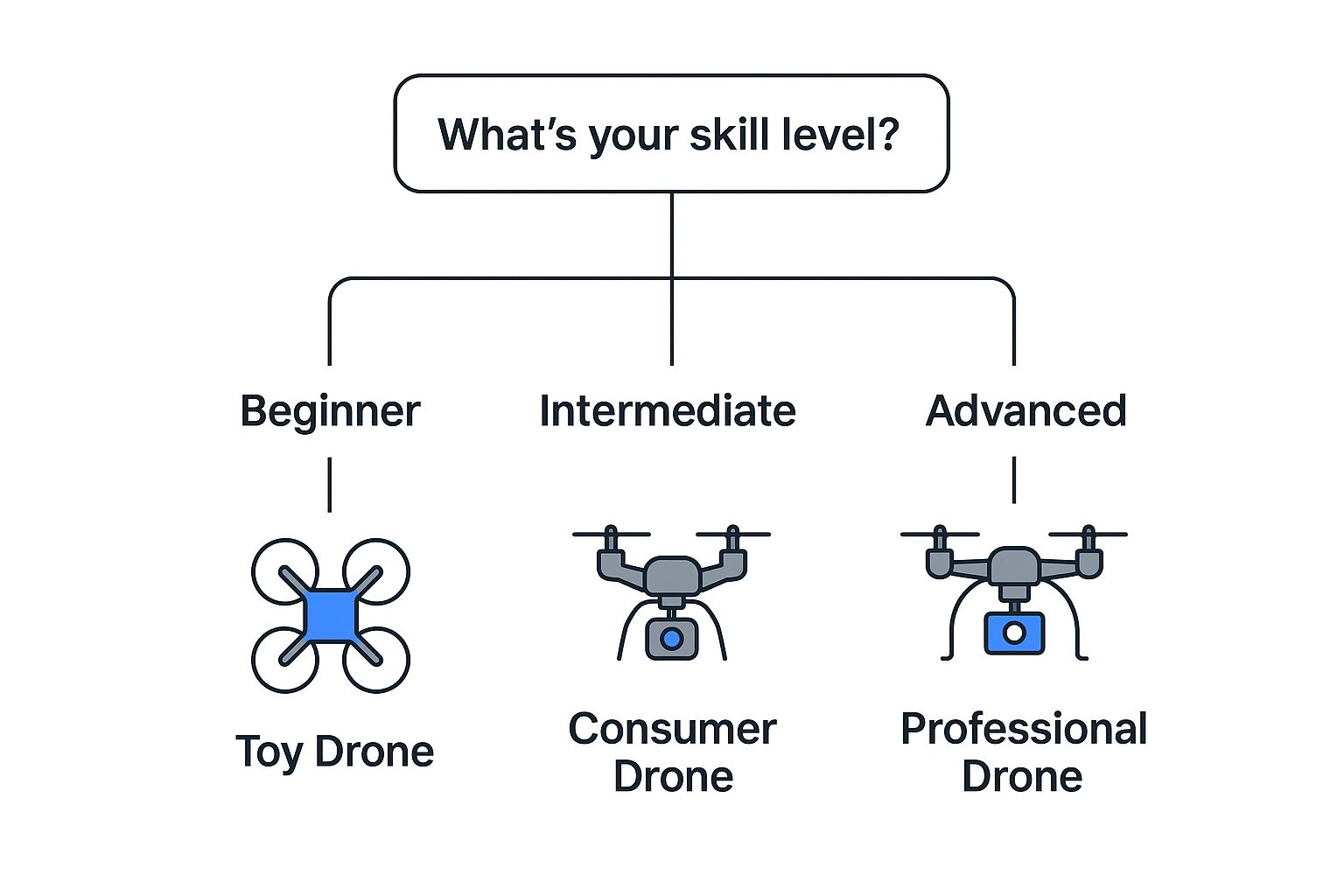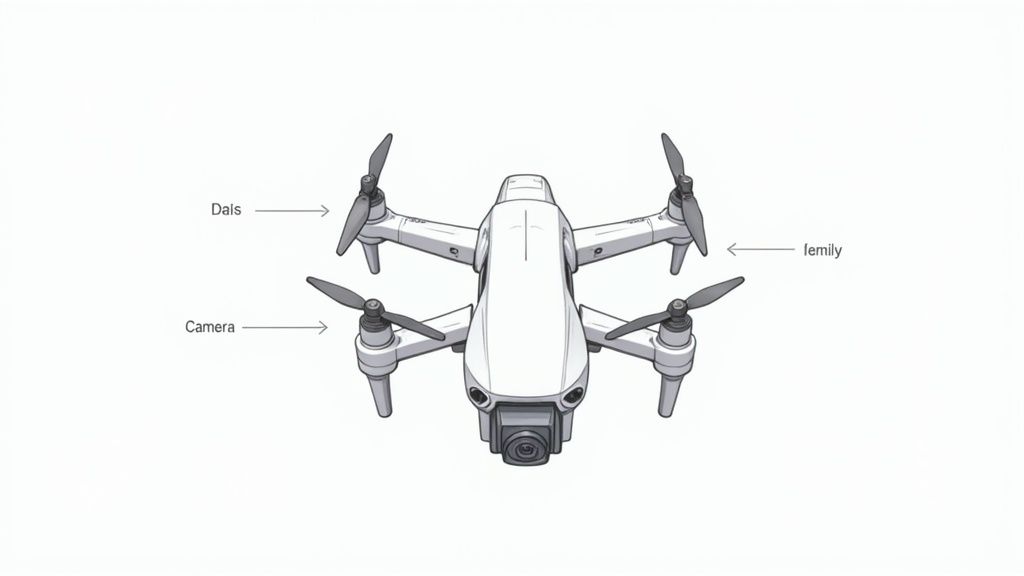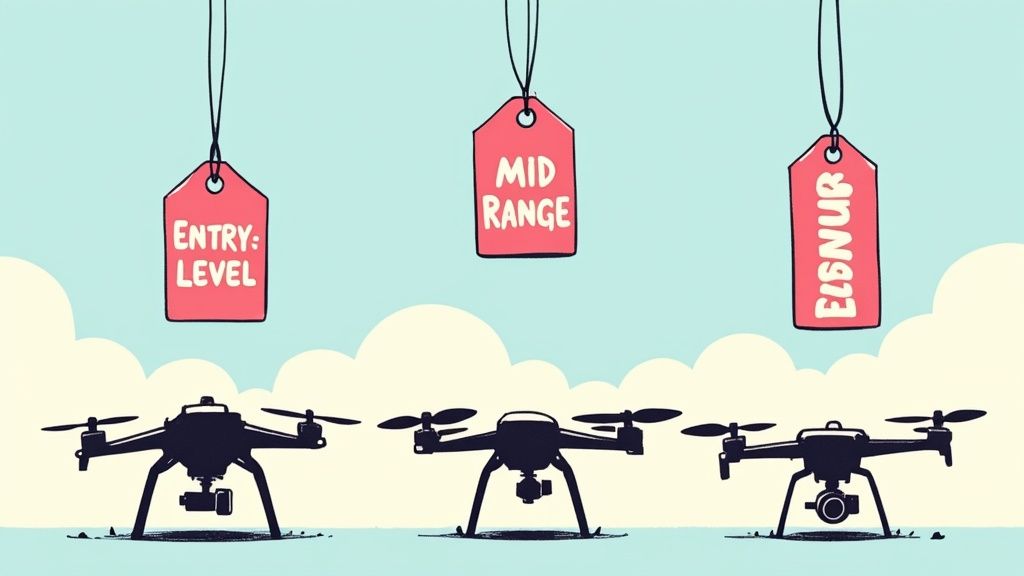How to Choose a Drone A Practical Guide
- Paul Simmons

- Jul 20
- 13 min read
Before you even think about spec sheets and technical jargon, choosing the right drone really comes down to one simple question: what’s your mission?
The best drone for you is the one that fits what you actually plan to do with it, whether that’s creating cinematic travel videos, inspecting a roof, or just having some fun on the weekends. It’s all about matching your needs to the right features, not just grabbing the most expensive model off the shelf.
Matching Your Drone to Your Mission
Let's get one thing straight: the perfect drone for a real estate agent shooting property tours is completely different from what a hobbyist needs for racing with friends. Thinking about your "why" from the very beginning is the single most important step. It prevents that all-too-common buyer's remorse and makes sure you invest in a tool that actually works for you.
This decision has gotten both easier and more complicated over the years. The drone market has absolutely exploded, rocketing from $0.6 billion in 2016 to a massive $5.3 billion by 2022. This growth means there are more choices and better tech at every price point, so you can find a drone built for almost any task imaginable.
Define Your Primary Goal
So, what kind of pilot are you?
Are you a filmmaker chasing that buttery-smooth 4K footage? If so, you can't compromise on a high-quality camera with a 3-axis gimbal and a large sensor. Or maybe you're a land surveyor who needs centimeter-level accuracy for mapping projects. In that case, you’re looking for a specialized drone with an RTK or GNSS receiver.
Let’s break it down into a few common scenarios:
Casual Hobbyist: Your main goal is having fun and grabbing decent photos and videos for your social media. Portability, ease of use, and a friendly price tag are what you should focus on.
Serious Photographer/Videographer: You demand professional-level image quality. You'll want to look for features like a 1-inch sensor, full manual camera controls, and the ability to shoot in RAW.
Commercial Operator: This drone is a business tool, plain and simple. Reliability, long flight times, and specialized payloads—like thermal or multispectral sensors for inspections or agriculture—are your top priorities. For professionals with specific industry needs, there are detailed guides on choosing the right drone for your industry that offer more tailored advice.
This quick reference table can help you connect your primary goal with the features that matter most.
Drone Features by Primary Use Case
Primary Use | Key Features to Prioritize | Example Scenario |
|---|---|---|
Hobby & Recreation | Ease of Use, Portability, Decent Camera, Affordability | Capturing memories of a family vacation or a weekend hike. |
Photography & Videography | 1-inch or Larger Sensor, 3-Axis Gimbal, RAW/D-Log, Manual Controls | Creating high-quality content for a YouTube channel or a client's wedding. |
Real Estate & Inspection | High-Resolution Camera, Obstacle Avoidance, Good Flight Time | Filming a smooth property walkthrough or safely inspecting a rooftop. |
Mapping & Surveying | RTK/PPK Capability, High-Resolution Camera, Mission Planning Software | Creating precise 2D maps or 3D models of a construction site. |
Ultimately, the goal is to buy the right tool for the job.
Key Takeaway: Don't pay for features you'll never use. A professional cinema drone is serious overkill for casual weekend flights, and a basic toy drone will only frustrate someone trying to produce high-quality content.
This decision tree gives you a great visual for how your experience level points you toward the right type of drone.

As the chart shows, an honest assessment of your skills is the best way to narrow the field from dozens of models to just a handful. Once you’ve figured out your mission and skill level, you can start digging into the specs that actually matter for what you want to achieve.
Decoding Key Drone Specifications

Diving into a drone's spec sheet can feel like trying to read a foreign language. You see terms like "transmission range," "sensor size," and "gimbal" thrown around, but what do they actually mean for your real-world flying experience? Trust me, getting a handle on these details is the difference between buying a drone you love and one that collects dust.
Let's cut through the jargon and translate these technical specs into what they mean for performance. This way, you can confidently compare models and know exactly what you’re getting for your money.
Flight Time And Transmission Range
First up are two of the most critical numbers: flight time and transmission range.
You’ll see manufacturers advertise flight times like "34 minutes" or even "46 minutes," but take those with a grain of salt. Those numbers are always recorded in perfect, no-wind conditions. In the real world, a windy day, aggressive flying, or even cold weather can easily slash that time by 20-30%. Think of the advertised number as a best-case scenario and plan your flights accordingly.
Equally important is the transmission range. This dictates how far your drone can fly from the controller before the video feed starts to break up. A longer range isn't just for epic, long-distance shots; it's a massive safety feature. A stronger, more robust signal is far more resilient to interference, especially in urban areas, ensuring you stay connected and in control.
Expert Tip: I make it a rule to bring my drone home with at least 20% battery left. This gives you a crucial safety buffer for unexpected high winds or connection issues on the final approach.
The Camera System: A Deeper Look
For most of us, the camera is the whole point. It's where the magic happens, but not all drone cameras are created equal. The single most important component to understand is the camera sensor.
Sensor Size: You'll see specs like "1/2.3-inch," "1-inch," or even "Micro Four Thirds." The simple rule is that a larger sensor, like a 1-inch sensor, captures significantly more light. The result? Cleaner, more detailed, and more professional-looking images, especially in tricky low-light situations like sunrise or sunset.
Video Resolution: While 4K has become the standard for high-quality video, some drones now offer 5.3K or even higher. This extra resolution is a huge advantage in post-production, giving you the freedom to crop into a shot without losing that crisp sharpness.
The Gimbal: A 3-axis mechanical gimbal is absolutely non-negotiable if you want smooth, cinematic video. It’s a physical stabilizer that counteracts the drone's every tilt and vibration, completely eliminating shaky footage. Drones that rely on electronic stabilization just can't deliver the same buttery-smooth results.
Intelligent Flight And Safety Features
Today’s drones are packed with brilliant tech that makes flying safer and easier than ever. These aren't just gimmicks; they are genuine game-changers, especially if you're a new pilot trying to find your wings.
Obstacle avoidance is probably the most vital safety system. Drones equipped with sensors on the front, back, bottom, and even top can detect and automatically steer around objects like trees, power lines, and buildings. It’s an incredible safety net that has saved countless pilots from costly crashes.
Beyond just safety, intelligent flight modes unlock your creative potential. These are automated flight paths that let the drone perform complex maneuvers with a single tap, so you can focus on getting the shot.
Common Intelligent Flight Modes:
ActiveTrack: The drone locks onto and follows a subject, like a person, car, or boat.
QuickShots: The drone performs pre-programmed cinematic shots, like circling an object or flying away dramatically.
Waypoint Navigation: You can pre-plan a complex flight path on a map for the drone to follow autonomously, perfect for repeatable shots.
By truly understanding these core specifications, you move beyond the marketing hype. You can finally assess how a drone will actually perform for you and make an investment you'll be happy with for years to come.
Navigating Drone Laws and Regulations

There's an incredible sense of freedom that comes with sending a camera into the sky, but that freedom is paired with some serious responsibilities. Before you even think about buying a drone, you have to get a handle on the rules of the air. Trust me, ignoring drone laws isn't just bad form—it can land you in hot water with hefty fines and legal headaches.
The very first thing to figure out is why you're flying. The regulations draw a very clear line in the sand between two types of drone operations:
Recreational Flying: This is you, in a park, flying just for the fun of it. The rules are generally a bit more relaxed, but safety is still paramount.
Commercial Flying: If your flight benefits a business in any way—whether you're selling aerial photos or doing a roof inspection for a client—you've crossed into commercial territory. In the U.S., this means you need a Part 107 certificate from the FAA.
Getting this distinction right is the bedrock of flying legally.
Weight And Registration Rules
Not every drone needs to be registered with the government, and it all boils down to one simple thing: weight. This is a massive factor when choosing your drone because it directly ties into the legal hoops you'll need to jump through.
In the United States and many other countries, drones that weigh less than 250 grams (or 0.55 lbs) don't need to be registered for recreational flying. This is precisely why you see so many "sub-250g" models flooding the market. Manufacturers design them specifically to sneak under that regulatory threshold, making them incredibly convenient for hobbyists.
The moment your drone hits 250 grams or more, though, registration becomes mandatory. You'll need to register it with your country's aviation authority, like the FAA in the States. The process itself is usually cheap and straightforward, but it is absolutely not optional. For a full breakdown, our **guide to registering a drone** walks you through the process with easy steps and tips to get you compliant fast.
Knowing Where You Can Fly
A classic rookie mistake is thinking you can fly just about anywhere. Unfortunately, that couldn't be further from the truth. For public safety and security, there are a ton of restricted areas where flying a drone is strictly off-limits.
Common No-Fly Zones:
Near airports (usually a 5-mile radius)
Over most national parks and many state parks
Around stadiums during events or large public gatherings
Near sensitive government buildings or military installations
Before you launch, every single time, you need to check the airspace. Use an official app like the FAA’s B4UFLY in the U.S. These tools give you real-time maps that show you exactly where you can and cannot fly safely.
Key Takeaway: The golden rule of safe flying is maintaining visual line of sight (VLOS). You must always be able to see your drone with your own eyes—no binoculars allowed—to prevent collisions and stay in complete control.
Beyond the basics, you also have to consider the bigger picture. Modern drone ownership means keeping an eye on both technology and global regulations. Things like FAA authorizations for flying beyond your line of sight (BVLOS) and even geopolitical tensions can impact which drones are certified and available for purchase. Making sure your drone is a good long-term investment means looking at its compliance right alongside its camera specs.
Setting a Realistic Drone Budget
Figuring out how much to spend on a drone can feel like the hardest part of the whole process. It’s way too easy to get mesmerized by the high-end models, but setting a realistic budget from the get-go ensures you get the right tool for the job without any buyer's remorse.
Let's break down what your money actually buys you at different price points. This isn't just about the number on the price tag; it's about understanding the total cost of getting in the air safely and effectively. You’ve got to think about the drone and the gear that turns it from a cool toy into a capable machine.
The Major Budget Tiers
The drone market really boils down to three main categories. Each one is built for a different kind of pilot with different goals. Knowing where you fit in helps align what you expect with what you can afford.
Sub-$300 Beginner Drones: This is your starting line. Drones in this price range are fantastic for one thing: learning how to fly. You'll have to accept some trade-offs, though. Camera quality will be basic, battery life often clocks in under 20 minutes, and you won't get the rock-solid GPS stability of more expensive models. They're great for casual fun, but you'll outgrow them fast if you're serious about creating content.
$400 - $1000 Hobbyist Sweet Spot: For most people, this is the magic zone. This is where you'll find the best bang for your buck and where serious hobbyists and aspiring creators should be looking. You see a huge jump in features, with 3-axis gimbals, reliable GPS, and impressive 4K cameras becoming standard. Flight times regularly push past the 30-minute mark, and you get smart features like subject tracking that make getting great shots so much easier.
$2000+ Professional Grade: Welcome to the big leagues. Drones at this level are workhorses designed for commercial jobs. Here, you're paying for things like premium camera sensors (1-inch or larger), incredible flight stability even in windy conditions, advanced obstacle avoidance systems, and the ability to carry specialized payloads. These are serious tools built for reliability and top-tier performance.
Factoring in the Total Cost of Ownership
Your spending doesn’t stop after you buy the drone. That initial purchase is just step one. To really make the most of your new gear, you have to budget for a few key accessories that are pretty much non-negotiable for any pilot.
A drone sitting on the shelf because you ran out of batteries is a wasted investment. Always budget for at least two extra batteries to maximize your time in the field and make every outing worthwhile.
You absolutely need to think about these add-ons:
Extra Batteries: One battery gets you about 30 minutes of airtime. For any decent flying session, you’ll want at least three.
High-Speed MicroSD Cards: Recording high-resolution video needs fast, reliable storage. Skimping here can lead to lost footage.
A Durable Case or Bag: You just spent a lot of money; now you have to protect it. A good case is essential for preventing damage during transport.
ND Filters: Think of these as sunglasses for your drone’s camera. They're a must-have for getting that smooth, cinematic look in bright daylight.
These extras add up. It’s not unusual to spend an additional $200-$400 on top of a $1,000 drone for these must-haves. It's also smart to think about protecting your equipment from accidents; you can learn more about that with our complete guide on what drone insurance covers. Planning for these costs from the start means your drone will be ready to fly the moment you unbox it.
Future-Proofing Your Drone Investment

When you’re learning how to choose a drone, it’s so easy to get wrapped up in the shiny features available right now. But drone technology moves at a breakneck pace. The last thing you want is for that brand-new bird to feel like a relic in just a year or two.
Thinking about your drone’s longevity means looking ahead. You want to prioritize technology that feels cutting-edge today but is quickly becoming the new industry standard. This approach ensures you’re buying a tool that not only solves your problems now but also grows with you as your skills sharpen and your projects get more ambitious.
Look for Emerging Standard Features
Some "premium" features from just a few years ago are now essential for any drone to have real staying power. If you want your investment to last, these are the technologies you should put at the top of your list.
Robust Obstacle Avoidance: Drones with sensors on all sides—front, back, top, and bottom—are fast becoming the norm. This omnidirectional coverage is a critical safety net that protects your investment from accidental crashes, especially when flying in complex environments. Trust me, it’s a lifesaver.
AI-Powered Flight Modes: Automated flight paths like advanced subject tracking (ActiveTrack) are no longer just for the priciest models. They allow you to capture incredibly complex, professional-looking shots with ease, and the AI behind them is only getting smarter and more reliable with each firmware update.
Next-Generation Imaging: A bigger camera sensor is a fantastic start, but you also need to look for support for modern video codecs and color profiles. These give you way more flexibility in post-production, a non-negotiable for anyone serious about videography.
Choosing a drone is about anticipating where the market is headed. The global drone market, valued at USD 73.06 billion in 2024, is projected to soar to USD 163.60 billion by 2030. This explosive growth is fueled by huge leaps in battery life, AI navigation, and sensor quality. Learn more about these market dynamics from Grand View Research.
Prioritize a Modular or Expandable Platform
One of the smartest ways to future-proof your purchase is to choose a drone built on a flexible platform. This is especially true for commercial operators or serious hobbyists who might want to tackle different kinds of projects down the road.
A drone that supports interchangeable payloads—like swapping a standard camera for a thermal sensor or a multispectral camera—opens up a world of possibilities. What starts as a tool for stunning photography could evolve into a machine for agricultural analysis or even search and rescue operations.
This adaptability extends to the software, too. Opting for a model from a manufacturer that provides consistent, meaningful firmware updates is crucial. These updates often unlock brand-new features, improve flight stability, and patch security holes, effectively giving your drone a new lease on life long after you bought it.
Keeping an eye on software updates is just as important as understanding the hardware. It's also vital to stay current with the rules of the sky. For more on that, check out our comprehensive guide to understanding drone regulations.
Common Questions About Choosing a Drone
Even after you think you've found the perfect drone, some last-minute questions always seem to surface. It's completely normal. Let's walk through some of the most common things aspiring pilots ask, so you can make your final choice with total confidence.
How Hard Is It to Learn to Fly?
Honestly, modern drones are incredibly easy to get into the air. Thanks to amazing features like GPS positioning and obstacle avoidance, most people feel comfortable with the basic controls within 15-20 minutes of their first flight. Automatic takeoff, landing, and stable hovering do most of the hard work for you.
The real challenge isn't just flying—it's flying smoothly to capture those beautiful, cinematic shots. That’s a skill that only comes with practice. But you definitely don't need to be an expert to get started. If you're brand new, check out some of the best beginner drone choices for aspiring pilots in 2025. These models are packed with safety features that make the learning curve much less intimidating.
What Is the Difference Between a Toy Drone and a GPS Drone?
This is a huge one, and the answer directly affects what you'll be able to do with your drone. The difference really boils down to stability and intelligent features.
Toy Drones (Under $100): These are pure manual control—no GPS. That means they drift with the slightest breeze and you're constantly fighting the controls just to keep them level. They're fun for practicing stick movements indoors but can be a nightmare to fly outside. Their cameras are usually very basic, too.
GPS Drones ($300+): These are the real deal. They use satellites to know exactly where they are. When you let go of the sticks, they just hang there, locked in place. This rock-solid stability is the foundation for every feature you actually want, like clear photos, smooth video, and life-saving return-to-home functions.
Key Takeaway: If your goal involves taking photos or videos you actually want to keep, a GPS drone isn't just a nice-to-have, it's a must-have. It’s the difference between usable footage and a shaky, frustrating mess.
Is the Fly More Combo Worth It?
In nearly every situation, yes, absolutely. You'll see manufacturers like DJI offer a "Fly More Combo" or a similar bundle. It’s the drone plus a collection of crucial accessories at a price that’s much lower than buying everything separately.
What's Usually Included:
Two extra batteries
A charging hub to charge all batteries at once
A decent carrying case
Spare propellers
Think about it this way: a single battery gives you roughly 30 minutes of flight time. A day of flying on one battery is over before it even starts. The Fly More Combo instantly triples your time in the air, turning a quick novelty flight into a proper, productive session. It’s one of the smartest investments you can make right from the start.
At JAB Drone, we're committed to providing the expert insights and in-depth reviews you need to navigate the world of aerial technology. From beginner guides to professional tips, we have the resources to help you fly safely and creatively. Explore our full range of content at https://www.jabdrone.com.




Comments